- In our view, the jobs report was mainly to the better side although the headline was weaker than expected. Employment grew by 151,000 in January, which was significantly lower than employment growth in Q4 (which was also revised down) and analysts’ expectations. Still the markets got some relief as markets likely expected a much more negative report. Also it is worth remembering that it is not unusual that we see slower employment growth in the following months when it has been higher-than-trend. Trend growth still seems solid, in our view.
- Also one has to take into account that the trend growth in the labour force is not that high. As we expect the participation rate to be fairly stable in the coming years, we expect the labour force to grow in the range of 100,000-150,000 per month over the next few years. Thus employment growth of 150,000 is likely sufficient to push down the unemployment rate. This effect was clear from today’s release as the unemployment rate fell to 4.9% in January from 5.0% in December (although the unemployment rate is based on a different survey than the nonfarm payrolls).
- Despite the weak activity data and poor market sentiment lately, the labour market still seems solid. Employment growth would have to decline significantly from its current pace to become a concern for Fed.
- Average hourly earnings (AHE) surprised on the upside. AHE rose 0.5% m/m in January which was higher than expected. Still, the annual growth rate declined from 2.7% in December to 2.5% in January but this mainly reflect that AHE made a jump in January last year. As AHE is by nature very volatile it is better to look at the trend. The annual growth rate in AHE has been trending up the last year and is currently nearly 1pp higher than in December 14. This reflects that the labour market has tightened significantly. As we expect the US labour market to tighten further this year, we also expect wage inflation will increase. We know from recent Fed communication that it would like to see more ‘hard’ evidence that inflation will increase. Hence, AHE will be an important market mover this year.
- Manufacturing employment continues to increase (although at a low level) the very weak manufacturing activity data in recent months. There is likely a lag between lower activity and employment, but so far employment within manufacturing has not suffered significantly. This is also positive for the overall impression of the US economy.
- With respect to our current Fed call, today’s release was no smoking gun. We still expect three hikes this year (April, September and December) although we recognise that risks are skewed towards later and fewer hikes. A smoking gun could be when Fed chair Yellen speaks next week. This is the first time we got to hear from her since Fed increased the target range in December and we will listen carefully to hear what she has to say.
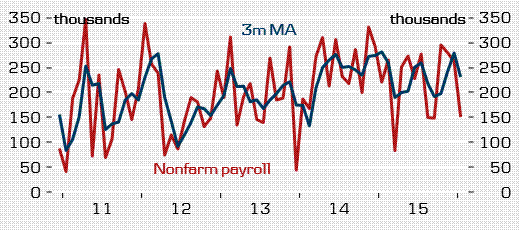
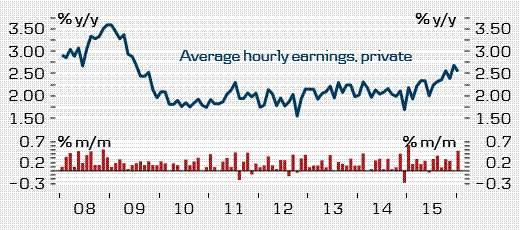
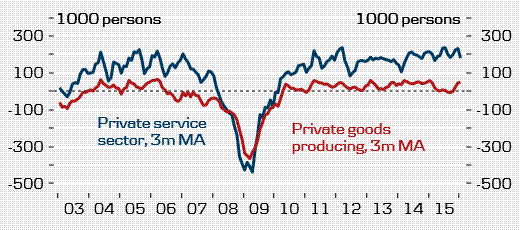
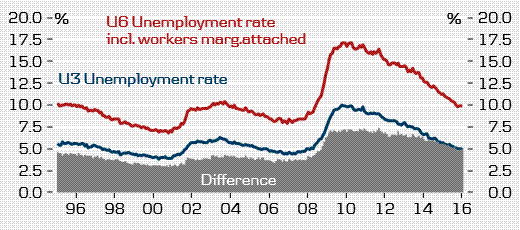
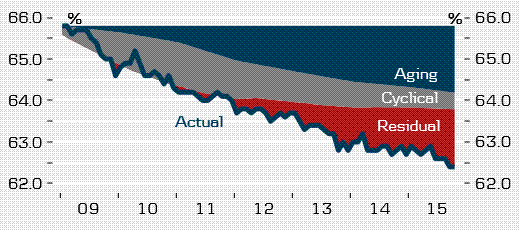
This publication has been prepared by Danske Bank for information purposes only. It is not an offer or solicitation of any offer to purchase or sell any financial instrument. Whilst reasonable care has been taken to ensure that its contents are not untrue or misleading, no representation is made as to its accuracy or completeness and no liability is accepted for any loss arising from reliance on it. Danske Bank, its affiliates or staff, may perform services for, solicit business from, hold long or short positions in, or otherwise be interested in the investments (including derivatives), of any issuer mentioned herein. Danske Bank's research analysts are not permitted to invest in securities under coverage in their research sector.
This publication is not intended for private customers in the UK or any person in the US. Danske Bank A/S is regulated by the FSA for the conduct of designated investment business in the UK and is a member of the London Stock Exchange.
Copyright () Danske Bank A/S. All rights reserved. This publication is protected by copyright and may not be reproduced in whole or in part without permission.
Recommended Content
Editors’ Picks
EUR/USD retreats below 1.0700 after US GDP data

EUR/USD came under modest bearish pressure and retreated below 1.0700. Although the US data showed that the economy grew at a softer pace than expected in Q1, strong inflation-related details provided a boost to the USD.
GBP/USD declines below 1.2500 as USD rebounds

GBP/USD declined below 1.2500 and erased the majority of its daily gains with the immediate reaction to the US GDP report. The US economy expanded at a softer pace than expected in Q1 but the price deflator jumped to 3.4% from 1.8%.
Gold holds near $2,330 despite rising US yields

Gold stays in positive territory near $2,330 in the second half of the day on Thursday. The benchmark 10-year US Treasury bond yield is up more than 1% on the day above 4.7% after US GDP report, making it difficult for XAU/USD to extend its daily rally.
XRP extends its decline, crypto experts comment on Ripple stablecoin and benefits for XRP Ledger

Ripple extends decline to $0.52 on Thursday, wipes out weekly gains. Crypto expert asks Ripple CTO how the stablecoin will benefit the XRP Ledger and native token XRP.
After the US close, it’s the Tokyo CPI

After the US close, it’s the Tokyo CPI, a reliable indicator of the national number and then the BoJ policy announcement. Tokyo CPI ex food and energy in Japan was a rise to 2.90% in March from 2.50%.